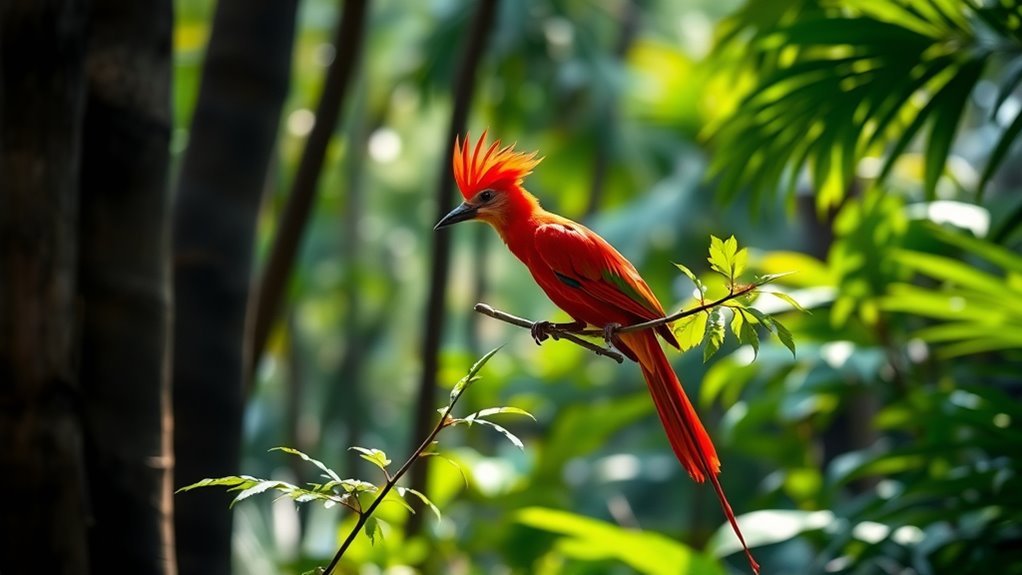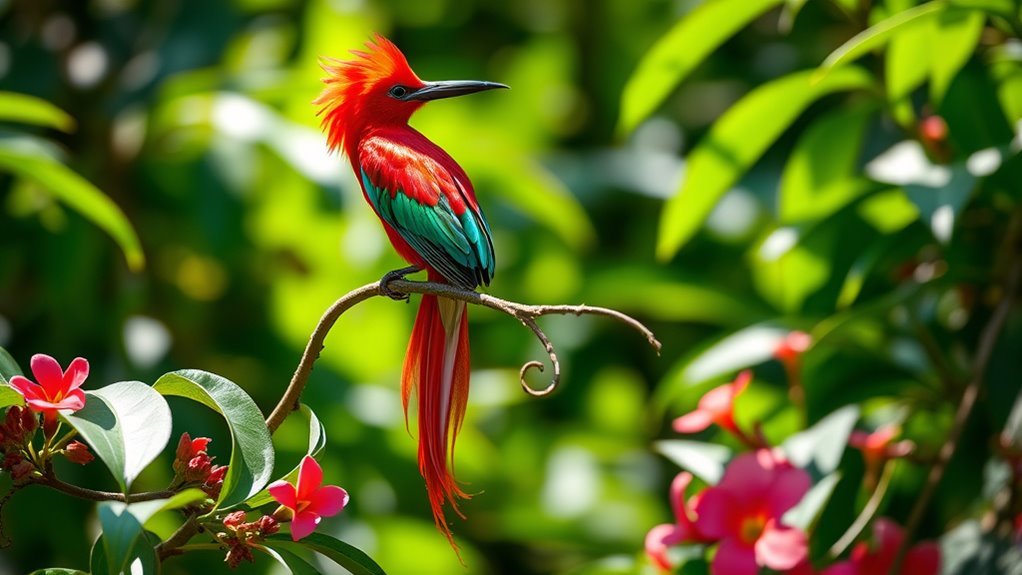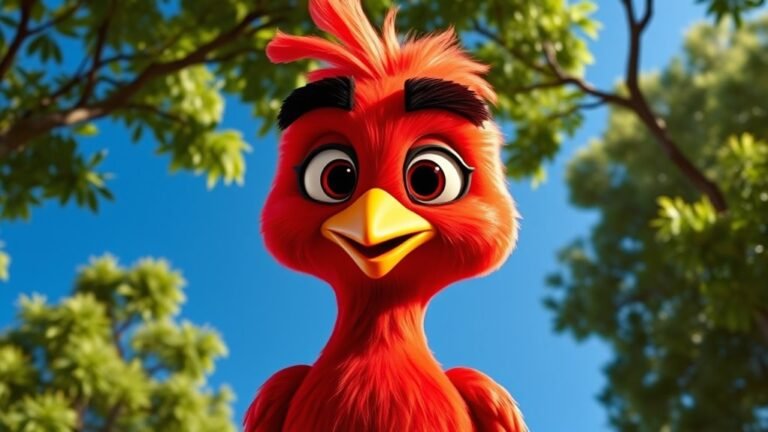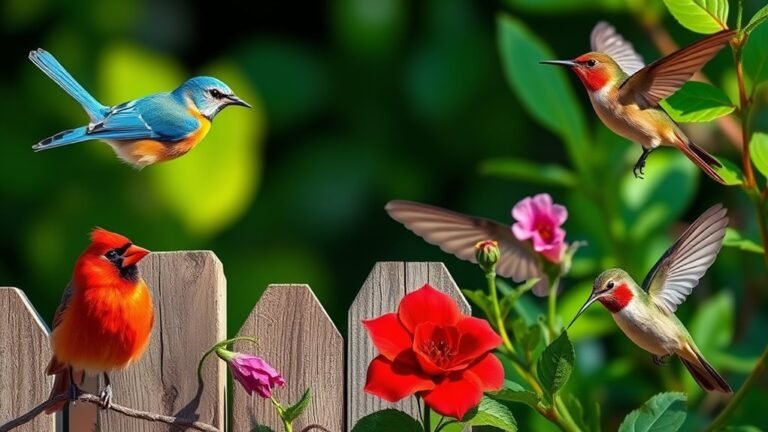The Stunning Red Bird of Paradise: Nature’s Beauty
The Red Bird of Paradise showcases bright red feathers with striking black and gold patterns. This bird attracts attention not just for its looks but also for its fascinating courtship dances. However, it faces threats like habitat loss and poaching. These issues make it important to support conservation efforts. What happens if we fail to protect their ecosystem?
Key Takeaways
- The Red Bird of Paradise features striking bright red feathers with unique black and gold patterns that signify its health and liveliness.
- Its captivating courtship rituals include elaborate feather displays, dances, and vocal sounds, showcasing its vibrant plumage as potential mates are attracted.
- This species predominantly thrives in tropical rainforests and lower montane forests of Indonesia, particularly New Guinea, highlighting its ecological significance.
- Conservation efforts are vital due to threats like habitat destruction, climate change, and poaching, which endanger the bird's population and its ecosystems.
- Protecting the Red Bird of Paradise and its habitat not only preserves its beauty but also contributes to biodiversity and environmental health.
Physical Features and Coloration

The Red Bird of Paradise features bright red feathers with unique black and gold patterns. These colors show the bird's health and liveliness, making it popular among bird watchers and nature lovers.
Its long tail feathers add to its beauty and elegance. The bird's compact body gives it charm.
Observing this bird highlights how its colors serve as a survival adaptation while showcasing the beauty of nature.
Courtship Behavior and Mating Rituals
The courtship behavior of the Red Bird of Paradise is captivating.
These birds perform elaborate rituals to attract mates. Their bright colors and movements create a stunning display.
Here are the key behaviors to observe:
- Feather displays show off their vibrant plumage.
- Mating dances include hops and turns.
- Vocal sounds enhance their displays and attract attention.
- Positioning helps draw in potential mates from distance.
These behaviors indicate their physical fitness and readiness to mate.
Watching these rituals gives insight into their unique mating process.
Enjoying their performances can deepen your appreciation for these beautiful creatures.
Habitat and Distribution

The Red Bird of Paradise has distinct habitat preferences. It thrives in tropical rainforests, where it finds shelter and food in lush vegetation. These birds typically inhabit lower montane forests. The dense canopy in these areas is ideal for nesting and foraging.
Geographically, the Red Bird of Paradise is mainly found on the islands of Indonesia, especially around New Guinea and neighboring regions. Their limited distribution contributes to their cultural significance and biodiversity.
Recognizing their habitat is crucial for understanding their role in their ecosystems. Protecting these environments remains vital for their survival and the health of the ecosystems they support.
Conservation Status and Threats
The Red Bird of Paradise faces serious threats that endanger its survival.
These threats include:
- Habitat destruction from logging and agriculture.
- Climate change that alters their ecosystems.
- Poaching for their attractive appearance, which appeals to collectors.
- Invasive species that disrupt their natural environments.
These issues lower their populations and upset local ecosystems.
It's crucial to participate in conservation programs. Every effort helps to stabilize the Red Bird of Paradise's numbers.
By learning about these threats, you can feel connected to the preservation of nature.
We must work together to protect this beautiful species and its habitat.
Importance of Protecting Red Bird of Paradise Ecosystems

Protecting the ecosystems that support the Red Bird of Paradise is crucial for its survival and overall environmental health.
By preserving these habitats, you help maintain biodiversity. This diversity supports many other species living there.
Healthy ecosystems provide clean air, water, and soil, which benefits all life, including humans.
When you work to safeguard these areas, you create a positive impact that strengthens their ability to adapt to changes.
Additionally, thriving ecosystems enhance our communities, fostering connections with nature.
By advocating for the habitats of the Red Bird of Paradise, you support not only this beautiful bird but also the diverse life it represents.
This effort ensures that future generations can appreciate its beauty.
Frequently Asked Questions
What Do Red Birds of Paradise Eat?
Red birds of paradise have interesting eating habits. They primarily eat fruits, insects, and nectar. Their diet highlights how they adapt to their environment. By understanding what they eat, you can see their important role in nature and how they maintain balance in their ecosystem.
How Long Do Red Birds of Paradise Live?
Red birds of paradise usually live for 10 to 15 years in the wild. Their lifespan depends on their breeding habits and the environment where they live. Providing a suitable habitat is important for their health and longevity.
Are They Solitary or Social Birds?
Red birds of paradise show interesting social behavior during mating rituals. They often gather in groups. In these groups, they display their bright colors and perform elaborate dances to attract mates. This behavior helps build connections within their species.
Can Red Birds of Paradise Be Kept as Pets?
Keeping red birds of paradise as pets is not recommended. They require specific housing and social needs that can be difficult to meet. These birds need a lot of space to fly and play, as well as daily interaction. Caring for them can be challenging for pet owners.
What Sounds Do Red Birds of Paradise Make?
Red birds of paradise make unique sounds during courtship. They use whistles and clicks to attract mates. Their calls are vibrant and help highlight their beauty. These sounds make them captivating creatures in their natural habitats.

Hello, I’m Amelia White, the founder of birdsfanatic.com. As a lifelong bird enthusiast and spiritual seeker, I’ve always been fascinated by the mystical connections between birds and the human experience. On this site, I share my knowledge and insights into the symbolic meanings and spiritual significance of various bird species, exploring their roles in mythology, folklore, and cultural traditions. Join me on this journey into the world of birds, where we’ll discover the hidden wisdom and guidance that these magnificent creatures have to offer.







